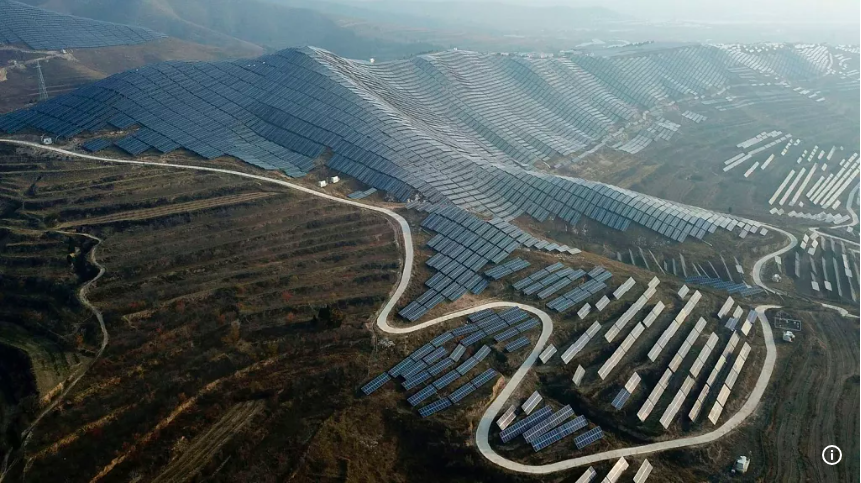Turning Coal Mines into Solar Farms Could Power a Nation Like Germany, Report Finds
Quote from Alex bobby on June 21, 2025, 9:54 AM

From Coal to Clean Power: How Abandoned Mines Could Energise a Nation the Size of Germany
The Solar Potential Hidden Beneath Coal Dust
A groundbreaking report by the Global Energy Monitor (GEM) has unveiled a powerful opportunity for clean energy growth: turning abandoned coal mines into solar farms. These forsaken industrial sites, long symbols of environmental degradation and economic decline, may now offer a climate-saving solution with the potential to generate nearly 300 gigawatts (GW) of solar energy—enough to meet the power needs of a country the size of Germany.
This marks a dramatic shift in how we view post-coal landscapes. Rather than leaving them to decay, the same ground that once fuelled the Industrial Revolution could now drive the global renewable energy transition.
A First-of-Its-Kind Analysis
The report draws on GEM’s Global Coal Mine Tracker, identifying 312 surface coal mines shut down since 2020, stretching across 2,089 square kilometres. An additional 3,731 square kilometres off land is expected to be abandoned by 2030 as mining operations cease. Combined, that amounts to 5,820 square kilometres—a space ripe for clean energy development.
If converted to solar farms, this land could deliver up to 300 GW of solar energy, equivalent to 15% of the current global installed solar capacity. It’s a powerful opportunity not just to reclaim land, but to redefine the legacy of coal itself.
“The legacy of coal is written into the land, but that legacy does not have to define the future,” says Cheng Cheng Wu, project manager for GEM’s Energy Transition Tracker.
Where the Solar Transition Is Happening
Leading the charge is China, with 90 coal-to-solar conversions already in operation (totalling 14 GW) and 46 more on the way. But the real opportunity lies globally—particularly in Australia, the United States, Indonesia, and India, which collectively account for nearly three-quarters of the coal-to-solar conversion potential.
In Europe, Greece stands out as exceptionally suited for this transition. With its average solar potential of 4.45 kilowatts per square meter, an ambitious coal phaseout by 2026, and EU-backed financial support, Greece is already setting up solar parks on former lignite mines, including in Western Macedonia. The country’s EU-funded Greece 2.0 recovery plan has earmarked €175 million to expand these efforts further.
Why Coal Mines Make Ideal Solar Sites
Repurposing abandoned coal mines for solar energy checks all the boxes of a sustainable development model:
- Land Availability: These sites are already cleared, often degraded, and no longer in use—eliminating the need to compete with agricultural land or forested areas.
- Clean Energy Production: Solar farms on mine lands can significantly contribute to the global goal of tripling renewable capacity by 2030.
- Conflict Avoidance: Unlike pristine land, old mines are less likely to trigger conflicts between stakeholders over land use, making them low-hanging fruit for renewable developers.
- Economic Revitalization: These projects offer tangible hope for former coal communities, providing new jobs, infrastructure, and a fresh purpose for regions often left behind.
A Just Transition: Jobs, Restoration, and Renewable Power
The employment benefits of coal-to-solar conversion are staggering. GEM estimates the creation of 259,700 permanent jobs and 317,500 temporary or construction jobs from these projects. That’s more than the entire global workforce expected to be lost as the coal industry winds down by 2035.
Aside from job creation, this strategy also supports land restoration. Historically, defunct coalfields have been abandoned, often polluting nearby ecosystems and communities. By turning them into solar farms, these areas gain an economic and environmental reason to be rehabilitated.
“Repurposing mines for solar development offers a rare chance to bring together land restoration, local job creation, and clean energy deployment in a single strategy,” says Wu.
Reclaiming the Past, Powering the Future
The coal industry has long been a cornerstone of industrial economies, but its environmental and health costs are well-documented. Now, with global momentum building behind the green transition, these same sites can offer a powerful pathway forward.
“We’ve seen what happens in coal communities when companies go bankrupt, axe the workers, and leave a mess behind,” notes Ryan Driskell Tate, associate director at GEM.
“But mined-out coalfields harbour huge potential for powering a clean energy future. It’s already happening. We just need the right mix of incentives to put people to work building the next generation of solar in coal country.”As the world races to reduce emissions and build a sustainable future, transforming dead zones of extraction into hubs off innovation and clean power isn’t just visionary—it’s essential.
Conclusion:
The path from coal to clean energy is clearer than ever. With the right policy, investment, and community engagement, abandoned coal mines could become the unlikely heroes of the renewable revolution—lighting the way for nations and generations to come.
A new report reveals that repurposing abandoned coal mines into solar farms could generate 300 GW of clean energy—enough to power a country as large as Germany. Discover the global potential and benefits of this transformation.
coal-to-solar, renewable energy, solar farms, coal mine repurposing, green jobs, clean energy transition, GEM report, solar power, climate solutions

From Coal to Clean Power: How Abandoned Mines Could Energise a Nation the Size of Germany
The Solar Potential Hidden Beneath Coal Dust
A groundbreaking report by the Global Energy Monitor (GEM) has unveiled a powerful opportunity for clean energy growth: turning abandoned coal mines into solar farms. These forsaken industrial sites, long symbols of environmental degradation and economic decline, may now offer a climate-saving solution with the potential to generate nearly 300 gigawatts (GW) of solar energy—enough to meet the power needs of a country the size of Germany.
Register for Tekedia Mini-MBA edition 19 (Feb 9 – May 2, 2026): big discounts for early bird.
Tekedia AI in Business Masterclass opens registrations.
Join Tekedia Capital Syndicate and co-invest in great global startups.
Register for Tekedia AI Lab: From Technical Design to Deployment (next edition begins Jan 24 2026).
This marks a dramatic shift in how we view post-coal landscapes. Rather than leaving them to decay, the same ground that once fuelled the Industrial Revolution could now drive the global renewable energy transition.
A First-of-Its-Kind Analysis
The report draws on GEM’s Global Coal Mine Tracker, identifying 312 surface coal mines shut down since 2020, stretching across 2,089 square kilometres. An additional 3,731 square kilometres off land is expected to be abandoned by 2030 as mining operations cease. Combined, that amounts to 5,820 square kilometres—a space ripe for clean energy development.
If converted to solar farms, this land could deliver up to 300 GW of solar energy, equivalent to 15% of the current global installed solar capacity. It’s a powerful opportunity not just to reclaim land, but to redefine the legacy of coal itself.
“The legacy of coal is written into the land, but that legacy does not have to define the future,” says Cheng Cheng Wu, project manager for GEM’s Energy Transition Tracker.
Where the Solar Transition Is Happening
Leading the charge is China, with 90 coal-to-solar conversions already in operation (totalling 14 GW) and 46 more on the way. But the real opportunity lies globally—particularly in Australia, the United States, Indonesia, and India, which collectively account for nearly three-quarters of the coal-to-solar conversion potential.
In Europe, Greece stands out as exceptionally suited for this transition. With its average solar potential of 4.45 kilowatts per square meter, an ambitious coal phaseout by 2026, and EU-backed financial support, Greece is already setting up solar parks on former lignite mines, including in Western Macedonia. The country’s EU-funded Greece 2.0 recovery plan has earmarked €175 million to expand these efforts further.
Why Coal Mines Make Ideal Solar Sites
Repurposing abandoned coal mines for solar energy checks all the boxes of a sustainable development model:
- Land Availability: These sites are already cleared, often degraded, and no longer in use—eliminating the need to compete with agricultural land or forested areas.
- Clean Energy Production: Solar farms on mine lands can significantly contribute to the global goal of tripling renewable capacity by 2030.
- Conflict Avoidance: Unlike pristine land, old mines are less likely to trigger conflicts between stakeholders over land use, making them low-hanging fruit for renewable developers.
- Economic Revitalization: These projects offer tangible hope for former coal communities, providing new jobs, infrastructure, and a fresh purpose for regions often left behind.
A Just Transition: Jobs, Restoration, and Renewable Power
The employment benefits of coal-to-solar conversion are staggering. GEM estimates the creation of 259,700 permanent jobs and 317,500 temporary or construction jobs from these projects. That’s more than the entire global workforce expected to be lost as the coal industry winds down by 2035.
Aside from job creation, this strategy also supports land restoration. Historically, defunct coalfields have been abandoned, often polluting nearby ecosystems and communities. By turning them into solar farms, these areas gain an economic and environmental reason to be rehabilitated.
“Repurposing mines for solar development offers a rare chance to bring together land restoration, local job creation, and clean energy deployment in a single strategy,” says Wu.
Reclaiming the Past, Powering the Future
The coal industry has long been a cornerstone of industrial economies, but its environmental and health costs are well-documented. Now, with global momentum building behind the green transition, these same sites can offer a powerful pathway forward.
“We’ve seen what happens in coal communities when companies go bankrupt, axe the workers, and leave a mess behind,” notes Ryan Driskell Tate, associate director at GEM.
“But mined-out coalfields harbour huge potential for powering a clean energy future. It’s already happening. We just need the right mix of incentives to put people to work building the next generation of solar in coal country.”
As the world races to reduce emissions and build a sustainable future, transforming dead zones of extraction into hubs off innovation and clean power isn’t just visionary—it’s essential.
Conclusion:
The path from coal to clean energy is clearer than ever. With the right policy, investment, and community engagement, abandoned coal mines could become the unlikely heroes of the renewable revolution—lighting the way for nations and generations to come.
A new report reveals that repurposing abandoned coal mines into solar farms could generate 300 GW of clean energy—enough to power a country as large as Germany. Discover the global potential and benefits of this transformation.
coal-to-solar, renewable energy, solar farms, coal mine repurposing, green jobs, clean energy transition, GEM report, solar power, climate solutions
Uploaded files:Share this:
- Click to share on Facebook (Opens in new window) Facebook
- Click to share on X (Opens in new window) X
- Click to share on WhatsApp (Opens in new window) WhatsApp
- Click to share on LinkedIn (Opens in new window) LinkedIn
- Click to email a link to a friend (Opens in new window) Email
- Click to print (Opens in new window) Print



